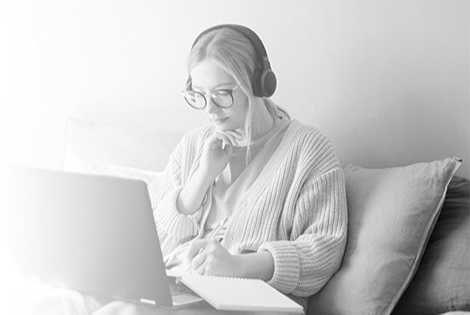History of the Icelandic Audio Library
The establishment of the Icelandic Audio Library is based on the regulation on the Blind Library of 7 May 1982. Prior to that time, there was a lot of pioneering work done, and the most prominent ones were Helgi Ólafsdóttir, the first director of the library, and Gísli Helgason, as well as the Blind Society pushing for improvements.
The first audio books or first book readings were created with the use of tape recorders in the sixties. Reading on tape recorders was started by the Blind Society of Iceland around 1955 and in 1957 the same kind of reading started at Blindrafélagið. Blindrafélagið furnished a special room for audio book readings in Hamrahlíð 7. Blindrafélagið lent blind and visually impaired people tape recorders for listening but Blindrafélagið ensured that blind and visually impaired people could acquire a device at a very good price. All who read in did so as a volunteer and were often reading at home in varied circumstances.
In 1975 the Blind Society and the City Library entered into an agreement on the publishing and distribution of audio books. The City Library was responsible for the recording and distribution, while the Blind Society recorded the books. This led to the establishment of a sound library called Bókin heim, located in Sólheimasafn and later in Hólmgarður. Due to popularity, a sound library division was established within the City Library in connection with the Blind Society and the number of audio books increased from year to year. This division served not only the visually impaired citizens of the city but the whole country.
In 1979, the state’s participation was considered, as the Nordic countries had been running blind libraries for many years. In October 1979, Helga Ólafsdóttir and Gísli Helgason attended a meeting with Minister of Education Ragnar Arnaldur and a bill for a blind library was passed by the Icelandic parliament in 1982.
The Blind Library of Iceland began operations in early 1983 and was opened in the building of Blindrafélagið to Hamrahlíð 17 on 22 February 1984. Initially, 1-10 copies of each book were produced and the library’s problem was that too few titles were recorded, in too few copies. Magnetic tapes and later CDs were sent all over the country and the loan recipients were very grateful for this service.
The library moved to Digranesvegur 5 in Kópavogur in 1994 in a spacious building, as it needed a lot of space for the library. The library was mainly on smart and later CDs. Also, point-of-section material was produced, but this activity was moved in the beginning of 2008-2009 to the Service and Knowledge Centre for the Blind, the Visually Impaired and Individuals with Integrated Visual and Hearing Impairments.
The library has always tried to keep an eye on technological developments in the distribution of material and as early as the turn of the century, a large part of the library’s books were recorded digitally instead of tape recordings, which was the main form of preservation.
In 2008-2009 there was a revolution in the distribution of audiobooks and all the activities of the museum when older audiobooks were transferred to digital form. A lot of work was put into digitizing the collection and the project was costly. Then the marriage gift of the couple, Málmfríður Jóhannsdóttir (1916-2007) and Finnbogi Bjarnason (1926-2006), was useful, but they inherited the collection from their house to promote the operation.
The name of the library was changed in 2013 and the Icelandic Audio Library was created. The regulation on the library states: “The role of the Icelandic Audio Library is to provide library services to those who cannot use the normal printed fonts by means of the dissemination of a wide variety of library material. This can include blind, visually impaired, dyslexic etc. Special emphasis should be placed on educational services.”
The library celebrated its 40th anniversary in 2022. A celebration was held on Digranesvegur on 5 May, a comprehensive strategy and vision was developed and a new website was created. The library has changed a lot over the last 40 years, as today it is mostly an electronic library, although there are still burned CDs for the group that chooses to use that technology. The library was originally intended for blind and visually impaired people only, but in the 1990s the library expanded and began accepting certificates from people with dyslexia, in line with sister institutions in the Nordic countries. The revised Copyright Act 2021 defines who is entitled to become a beneficiary of the library.
Supporters of the Blind Library/Hljóðbókasafn have supported the library since its inception. Many organisations and individuals have contributed greatly through volunteer work and support for the library, and the Blind Society is the front-runner. The Reykjavík chapter of the Red Cross of Iceland also gave the library great support for many years and for a period of time the library received special income from the Blind Library’s Grant Fund (founded in 1989) and from the Blind Library’s Friends’ Association (founded in 1993).

